What Is Rock Bolt? Common Types and Applications
Time:2023-11-24From:sinorock View:
Introduction
The emergence of rock bolts has greatly improved the safety of the mining and underground excavation industry. Rockfall and collapse are the crucial reasons for the failure of underground engineering and the high mortality before the development of ground support technology. It was not until the late 19th century that steel rock bolts were first used in mining. Up to now, rock bolt has been widely used in the construction of foundation support, tunnel excavation, and other projects for economical and high-safety features.
Rock bolt reinforcement can improve the strength and self-stability of rock mass, effectively control the deformation of geotechnical, and has a positive effect on the stability of tunnel excavation. The use of rock bolts in geotechnical engineering has become one of the most economical and effective methods to improve the stability of geotechnical engineering and solve complex engineering problems. This article will introduce the definition of rock bolts, types of rock bolts, and related application scenarios.
1. What Is Rock Bolt?
Rock bolts are steel threaded rods that are inserted into rock mass to stabilize underground rock and soil structures during excavation. In simple terms, rock bolt is embedded in the rock and can bear the tension of the rod.
The anchorage structure formed by a rock bolt adopts a prestressed bolt group, which can transfer the tensile stress of the structure to the deep stable strata or reinforce the unstable rock mass, and form a bearing structure system in which rock bolt and rock mass interact and work together. As a fundamental component in geotechnical engineering, rock bolts are instrumental in enhancing the stability and safety of tunnels, mines, and other subsurface structures.
2. Types of Rock Bolt
2.1 Self-Drilling Rock Bolt
Overview
Self-drilling rock bolts, also known as hollow bars. The self-drilling anchor system is composed of a hollow anchor bar, nut, plate, coupler, centralizer and drill bit. These bolts have a hollow core, allowing simultaneous drilling and injection of grout to consolidate the surrounding rock. It combines drilling, grouting, and anchoring functions together, which is suitable for broken rocks and surrounding rocks that are difficult to drill holes. The self-drilling rock bolt is suitable for broken rock, loose rock, and other geology that is difficult to form holes and easy to collapse. It can greatly improve the supporting effect in complex geology and achieve the best construction effect.
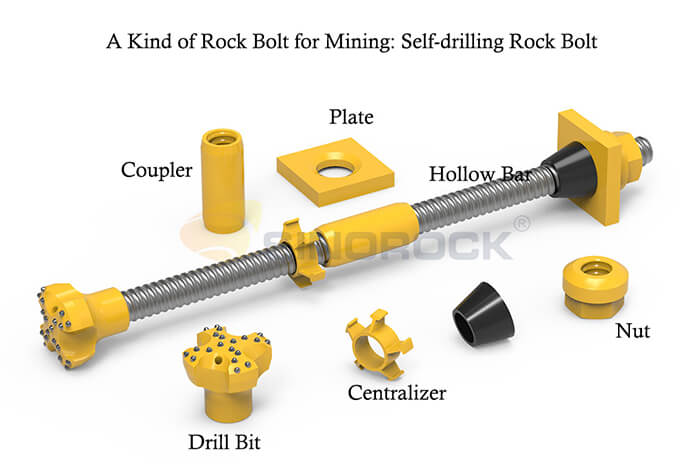
Advantages
- Efficient installation
- Reduced time and labor costs
- Enhanced grouting for improved rock reinforcement
Applications
- Tunneling
- Slope stabilization
- Underground mining
2.2 Expansion Shell Hollow Rock Bolt
Overview
The expansion shell hollow anchor bar consists of a hollow anchor bar, plate, nut, and expansion shell. The expansion shell hollow anchor bar can be prestressed and can be adjusted by applying a torque wrench. The bolts are typically 1 to 5 meters in length and carry capacities from 100 to up to about 500KN. Mainly used in mining and tunnel systematic support.
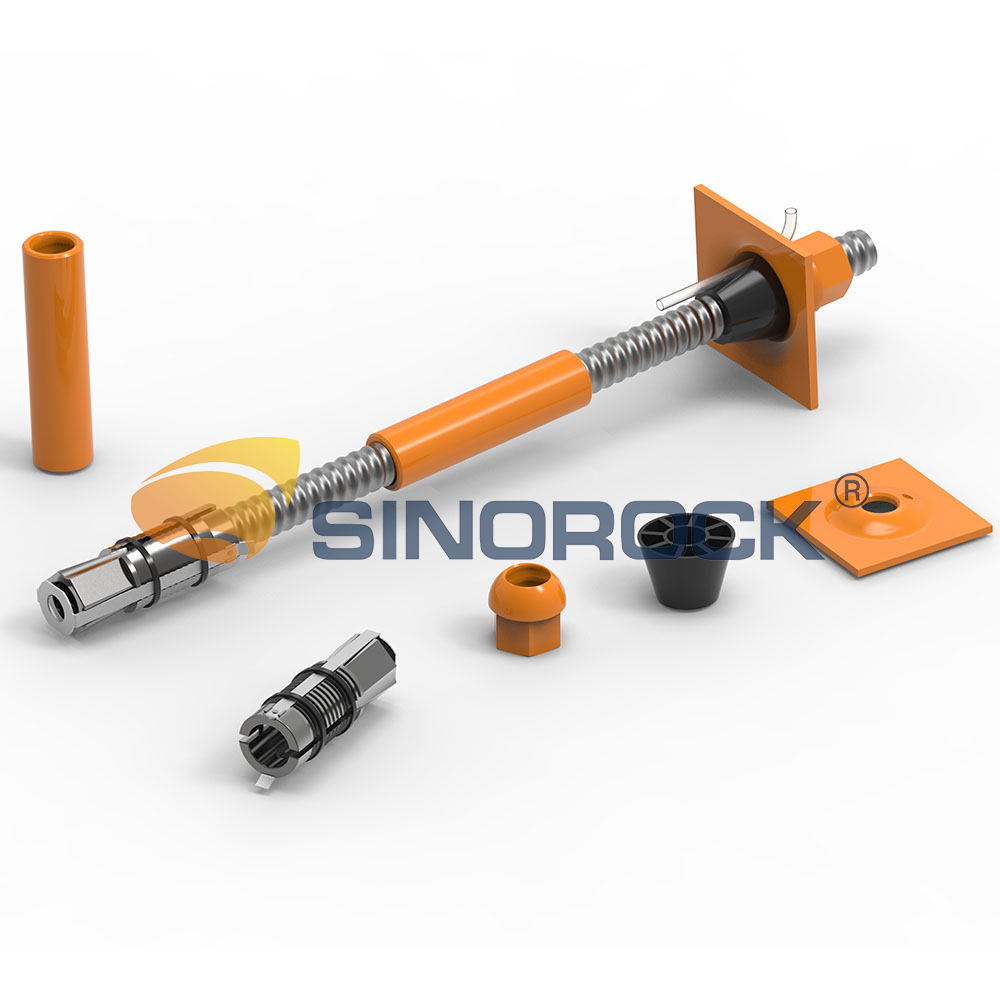
Advantages
- Versatile in different rock types
- High load-bearing capacity
- Suitable for dynamic rock conditions
Applications
- Civil engineering projects
- Roadway support
- Excavations in variable rock formations
2.3 Swellex Rock Bolt
Overview
Swellex rock bolt, also known as hydraulic expansion bolt, is composed of end sleeve, retaining ring, liquid injection end, tray and other accessories. The Swellex rock bolt is unique. It needs to put the bolt into the bolt hole and then use high-pressure water to make it expand. In the expansion process, the water-swelling bolt will produce permanent deformation, and the pipe wall will completely fit the irregular hole wall of the bolt hole. Friction and self-locking force are generated throughout the whole length of the bolt, thus strengthening the rock mass. Due to its quick installation, safety, reliability and high flexibility, the swellex-anchor has been widely used at present.
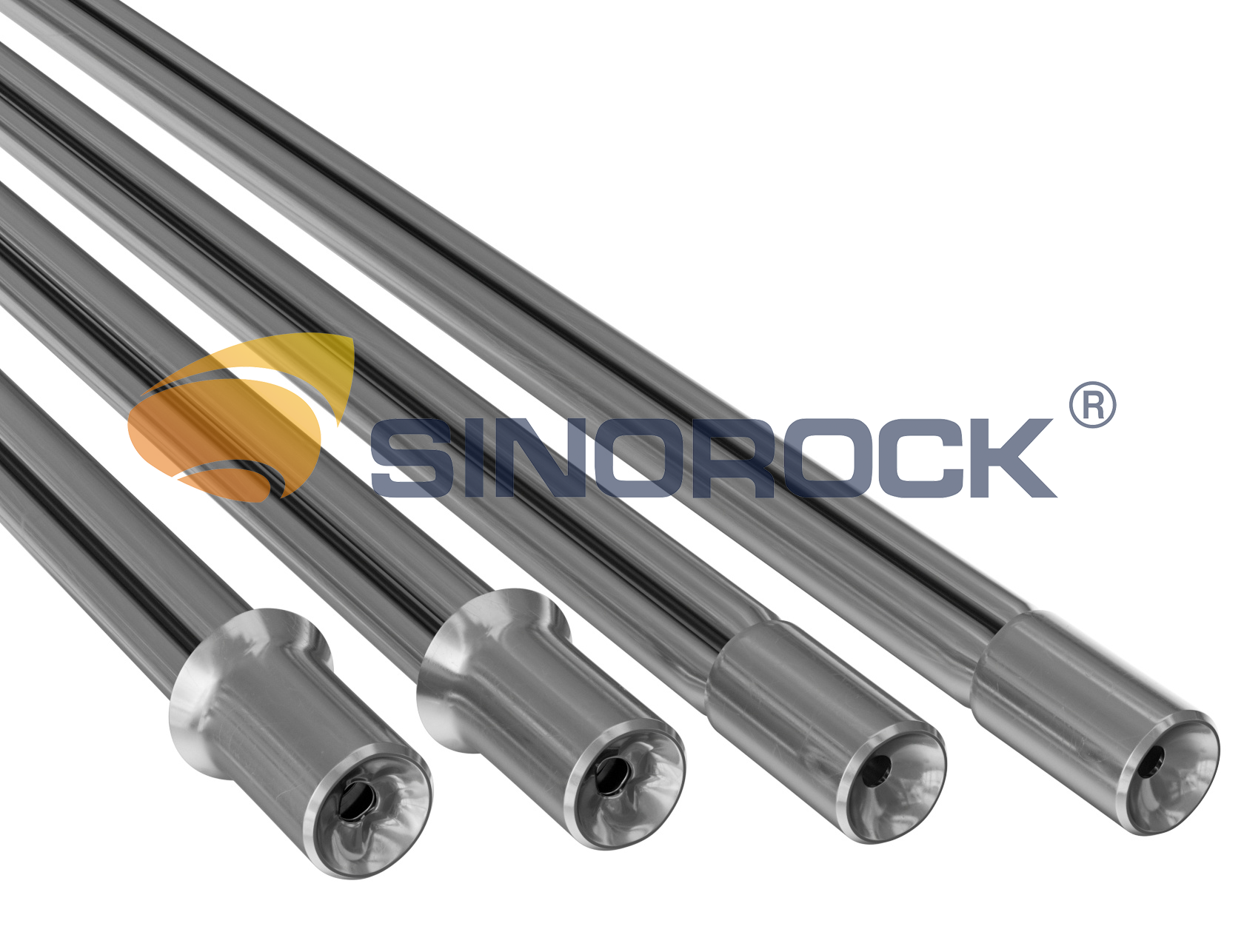
Advantages
- Conformity to irregular rock shapes
- Effective in weak rock formations
- Minimal drilling required
Applications
- Tunnels with varying rock conditions
- Underground chambers
- Slope stabilization
2.4 Refined Rolled Thread Bar
Overview
Refined rolled thread bars feature discontinuous threads, enhancing their gripping capability in the rock. These bolts provide reliable reinforcement in challenging geological settings.
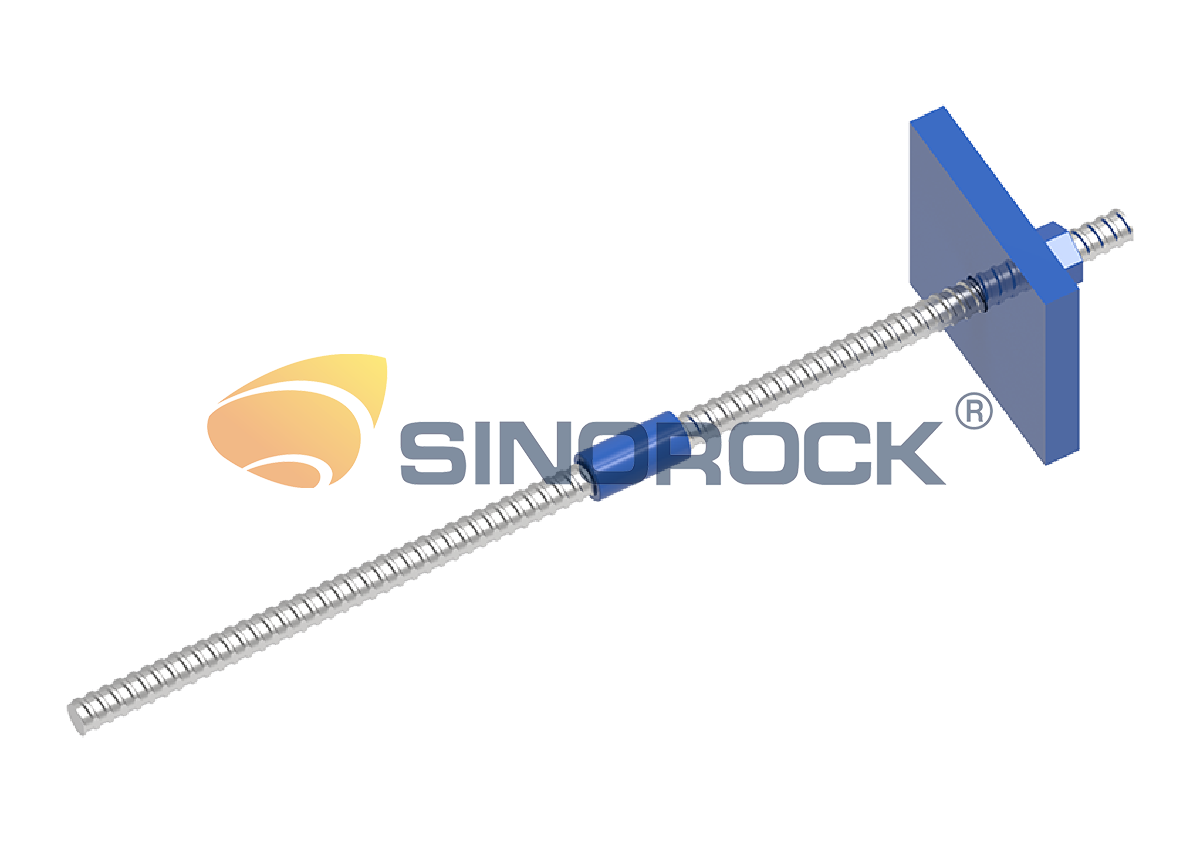
Advantages
- Increased frictional resistance
- Improved load transfer to the rock
- Resilience in fractured rock masses
Applications
- Deep excavations
- Rock slope stability
- Anchoring in fractured rock formations
2.5 Split Set Rock Bolts
Overview
Split Set rock bolts are simple, yet effective, featuring a tube with slits along its length. The bolt expands when inserted, providing radial pressure to stabilize the surrounding rock.
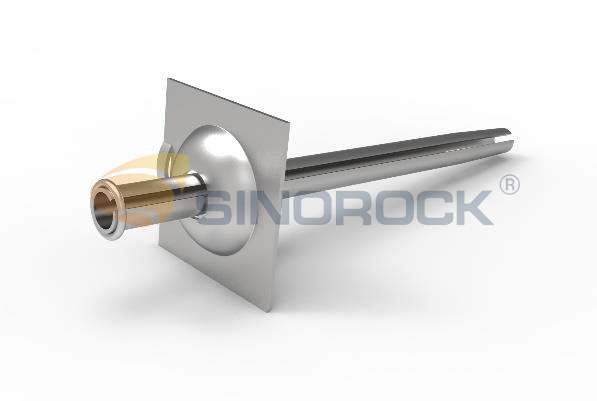
Advantages
- Quick and easy installation
- Applicability in tight spaces
- Cost-effective solution
Applications
- Temporary support in mining
- Tunnel face stabilization
- Emergency ground control
3. Common Applications of Rock Bolt
Rock bolts find diverse applications across various industries, contributing to the stability and safety of underground structures. Common applications include:
- Mining Operations: Providing roof support in underground mines.
- Tunneling Projects: Reinforcing tunnel walls and roofs.
- Civil Engineering: Stabilizing slopes and excavations.
- Hydroelectric Power Projects: Securing underground structures in dam construction.
- Roadway Support: Enhancing stability in road tunnels and cut slopes.
4. How to Install Rock Bolt?
The installation process of rock bolts is a critical aspect of ensuring their effectiveness. Proper installation involves:
1. Drilling: Creating a hole in the rock mass using specialized equipment.
2. Inserting the Bolt: Placing the appropriate rock bolt into the drilled hole.
3. Grouting: Injecting grout into the hole to fill voids and enhance rock reinforcement.
4. Tensioning: Applying tension to the bolt to secure it in place and maximize its load-bearing capacity.
Adhering to industry standards and guidelines during installation is paramount for the success of rock bolt applications.
5. Sinorock - Professional Rock Bolt Manufacturer
Sinorock stands at the forefront of rock bolt manufacturing, offering a comprehensive range of solutions to meet the diverse needs of the geotechnical industry. As a trusted partner in underground construction and stabilization, Sinorock distinguishes itself through:
- State-of-the-Art Manufacturing: Utilizing cutting-edge technology to produce high-quality rock bolts.
- Customization: Tailoring solutions to specific project requirements.
- Expertise: Backed by a team of experienced professionals in geotechnical engineering.
- Global Presence: Serving clients worldwide with a commitment to excellence.
Trust Sinorock for all your rock bolt needs and experience the assurance of stability and safety in underground environments.
Conclusion
In conclusion, rock bolts are indispensable elements in geotechnical engineering, providing essential reinforcement for underground structures. Understanding the types, applications, and proper installation methods is crucial for ensuring their effectiveness. Sinorock, with its commitment to excellence and global expertise, emerges as a reliable partner for all rock bolt requirements. Embrace the strength and stability that Sinorock brings to your underground projects, and unlock a new level of confidence in subsurface construction. Welcome to contact: sinorock@sinorockco.com
Related News
latest news
-

- What Are the Applications of SDA Bolts in Hydropower Stations?
- Time:2025-08-21From:This Site
- Learn how self-drilling anchor bolts enhance slope stability, tunnel support, and dam reinforcement in complex geological conditions at hydropower stations. Optimize hydropower projects with efficient, cost-effective, and eco-friendly solutions.
- View details
-

- Slope Stabilization with SDA Bolts: Benefits & Applications
- Time:2025-08-19From:This Site
- Discover how self-drilling anchor bolts (SDA bolts) provide superior slope stabilization for highways, railways, and tunnels. Learn their key benefits, installation process, and real-world applications in loose or collapsible soils.
- View details
-

- How Self-Drilling Rock Bolts Enhance Tunnel Support in Fractured Rock?
- Time:2025-08-15From:This Site
- Discover how self-drilling rock bolts enhance tunnel support in fractured rock. Learn their benefits, installation steps, and real-world applications for safe, efficient tunneling.
- View details
-

- Sinorock 2025 Quality Month | Strengthening Quality Foundations, Empowering Product Excellence
- Time:2025-08-13From:This Site
- Sinorock’s 2025 Quality Month, themed “Strengthening Quality Foundations, Empowering Product Excellence,” successfully concluded, reinforcing our commitment to superior product quality.
- View details
-

- Sinorock Safety Month 2025 | Everyone Speaks Safety, Everyone Can Respond
- Time:2025-07-03From:This Site
- Sinorock Safety Month 2025, centered on the theme "Everyone Speaks Safety, Everyone Can Respond - Spot Workplace Hazards," has wrapped up successfully!
- View details
-

- Quality Control: the Vital Factor of A SDA Bolt Factory
- Time:2025-01-09From:This Site
- Sinorock’s comprehensive quality control system, from supplier management to outgoing inspections, ensuring the highest standards for self-drilling anchor bolts in construction.
- View details
-

- Sinorock Invites You to Explore Proven Self-Drilling Anchor Bolt Solutions at bauma 2025
- Time:2025-03-07From:This Site
- From April 7–13, 2025, explore Sinorock’s Self-drilling anchor bolt solution at Booth C2.513/4 in Hall C2 of the Messe München Exhibition Center (Munich, Germany).
- View details
-
.jpg)
- SINOROCK to Attend EXPOMINA PERÚ 2024 in Lima, Peru
- Time:2024-08-10From:This Site
- Sinorock to Attend EXPOMINA PERÚ 2024 in Lima, Peru
- View details
-
.jpg)
- SINOROCK to Participate in MINING AND METALS CENTRAL ASIA 2024
- Time:2024-08-08From:This Site
- SINOROCK to Participate in MINING AND METALS CENTRAL ASIA 2024
- View details
 Download
Download 


